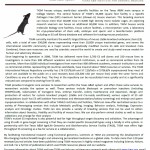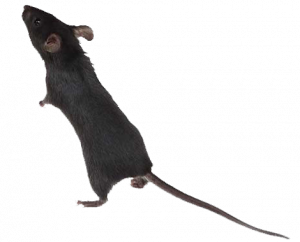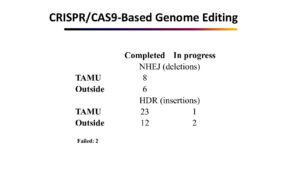TIGM: A Worldwide Resource for lncRNAs KO ES cells
Texas A&M Institute for Genomic Medicine (TIGM) houses the world’s largest library of knockout C57BL/6N ES cells and provides transgenic mice for researchers worldwide. Long non-coding RNAs (lncRNA) are non-protein coding transcripts longer than 200 nucleotides. A handful of studies have implicated lncRNAs in a variety of disease states and demonstrated their involvement in oncogenesis. The 500,000 sequence tags, which were produced in the course of generating the 350,000 gene trapped clones, were compared to the latest build (38) of the mouse genome using BLAST. Our screening of more than 18,000 clones has identified over 1,000 inactivated ncRNAs including a number of lncRNAs. For more information please see our poster. We are still working to update our database with these clones and ncRNAs; in the meantime, if you can’t find clones for your gene, please contact us at info@tigm.org and we will check it for you.
NEWS
TIGM’s work will be presented at the 2015 Lone Star and South Central Joint Regional Chapter Annual Meeting to be held at Sheraton Suites Houston near the Galleria (2400 West Loop South, Houston, TX 77027) on October 22–24, 2015. See our abstract and poster.
Gene trap insertion produces a functional microRNA mutation.
TIGM gene trap library contains a subset of clones with insertion inside murine microRNAs. Together these mutations disrupt 15 unique miRNAs, representing only 3% of the mouse miRNA genes. There’s a much larger subset of clone with insertions near miRNA loci, but not inside these genes, and they were excluded from the list of potentially mutagenic gene traps. In turns out, however, that under certain circumstances such mutations may effectively knock out miRNAs. In a recent paper published in the May 23, 2014 issue of Elife and featuring mutant mice from TIGM’s C57BL/6 library, Elik Chapnik and colleagues reported production of fully functional miR-142 knockout from the TIGM clone carrying gene trap insertion ∼50 bp upstream of the murine pre-miR-142, but inside a larger primary miRNA (pri-miRNA) expressed by the mir142 host gene (miR-142 orchestrates a network of actin cytoskeleton regulators during megakaryopoiesis). This cassette disrupted normal transcription and drove the expression of a beta-galactosidase reporter gene. Genetic ablation of miR-142 caused impaired megakaryocyte maturation, inhibition of polyploidization, abnormal proplatelet formation, and thrombocytopenia. The miR-142 knockout ES cells are available at TIGM repository.
We are proud to announce that TIGM is a part of the Center for Translational Environmental Health Research (CTEHR)
As one of only 18 NIEHS Centers of Excellence in the country, CTEHR is now poised to lead the state and nation in human environmental health research. Its mission is to improve human environmental health by integrating advances in basic, biomedical, and engineering research and by promoting translation of these advances between the bench, the bedside, and the community. The CTEHR is a multi-university program, including Texas A&M University, Texas A&M AgriLife Research, Texas A&M HSC, Baylor College of Medicine, and the University of Houston. For more information please visit http://ctehr.tamu.edu/
Use of the gene trap mutation to disrupt a mitochondrial protein
TIGM gene trap mutations can effectively knock nuclear-encoded mitochondrial proteins. In a recent paper published in the 10 November issue of Nature Cell Biology and featuring a mouse produced from a TIGM’s C57BL/6 gene trapped clone, Xin Pan and colleagues characterized a mouse model that lacks expression of the mitochondrial calcium uniporter (Mcu) ( The physiological role of mitochondrial calcium revealed by mice lacking the mitochondrial calcium uniporter). Mitochondria derived from Mcu(-/-) mice have no apparent capacity to rapidly uptake calcium and Mcu(-/-) mice exhibited marked impairment in their ability to perform strenuous work. The authors further show that mitochondria from Mcu (-/-) mice lacked evidence for calcium-induced permeability transition pore (PTP) opening which does not seem to protect Mcu(-/-) cells and tissues from cell death, although Mcu (-/-) hearts fail to respond to the PTP inhibitor cyclosporin A. These results clarify how acute alterations in mitochondrial matrix calcium can regulate mammalian physiology. The Mcu knockout line is available at TIGM repository.
TIGM has reached a milestone of more than 100 known publications featuring mice or ES cells provided by TIGM
For the complete list please visit our publications page.
A US patent granted to Texas A&M features TIGM mice
CANCER TREATMENT TARGETING NON-CODING RNA OVEREXPRESSION. Stephen Safe, KyoungHyun Kim. United States Patent Application 20130267575. Filing Date: 03/07/2013; Publication Date: 10/10/2013. http://www.freepatentsonline.com/y2013/0267575.html
Texas A&M Institute for Genomic Medicine (TIGM) facilitates breakthroughs in science and medicine and accelerate the pace of medical discoveries through internal research and by providing our resources, training and services to the scientific community at Texas A&M, The State of Texas, and the world.
The Texas A&M Institute for Genomic Medicine (TIGM) is an essential resource for any researcher looking to obtain knockout mice and embryonic stem (ES) cells quickly and with favorable intellectual property (IP) terms. Our resources include the world’s largest gene trap library of ES cells in the C57BL/6N mouse strain and access to the largest library of ES cells in the 129/SvEvBrd mouse strain. TIGM provides both ES cell clones and mice to the public and private international research community.
Since beginning its operation in 2006, TIGM has served as a major resource to the international scientific community. In that time, TIGM has delivered more than 800 mouse and ES cells orders to more than 270 academic and commercial institutions in over 26 countries. In addition, a total of over 7,100 individual investigators from more than 900 academic and research institutions and commercial entities representing 40 countries, have queried TIGM with information requests.These resources are being used with great success and to date there are at more than 50 peer-reviewed publications featuring TIGM mice or cells.
For the complete list of publications please visit https://tigm.org/publications/
The World’s Largest Collection of ES Cells and Mice
The TIGM mouse knockout database currently includes links identifying embryonic stem cell clones from the C57BL/6 and 129S5/SvEvBrd gene trap libraries, as well as more than 2,500 established mouse knockout lines from the 129 line. Together, these resources cover more than 13,000 mouse genes and can be searched by gene or protein sequence, accession number, chromosome, gene ID or keyword. TIGM also offers more than 200 established cryopreserved lines in our mouse repository.
C57BL/6 Mice and ES Cell Clones
TIGM operates a gene trap library – a premier knockout mouse ES cell resource – that contains over 350,000 cell lines in the C57BL/6 mouse background. This library contains mutated ES cell clones representing more than 10,000 genes.
Knockout Resources
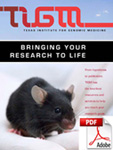 Download our brochure Download our brochure |
The Texas A&M Institute for Genomic Medicine (TIGM) is a part of the Texas A&M University System as a research institute of Texas A&M AgriLife Research. TIGM utilizes advanced technologies to discover breakthroughs in science and medicine and accelerate the pace of medical discoveries. TIGM accomplishes this through internal research and collaborations with other institutions. TIGM also maintains the world’s largest library of mouse knockout embryonic stem cells and provides both ES cells and mice to academic and commercial institutions around the world. |
Facilities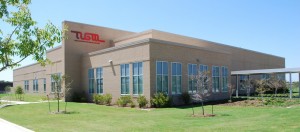
|
Publication describing our library and technology can be found here: |



